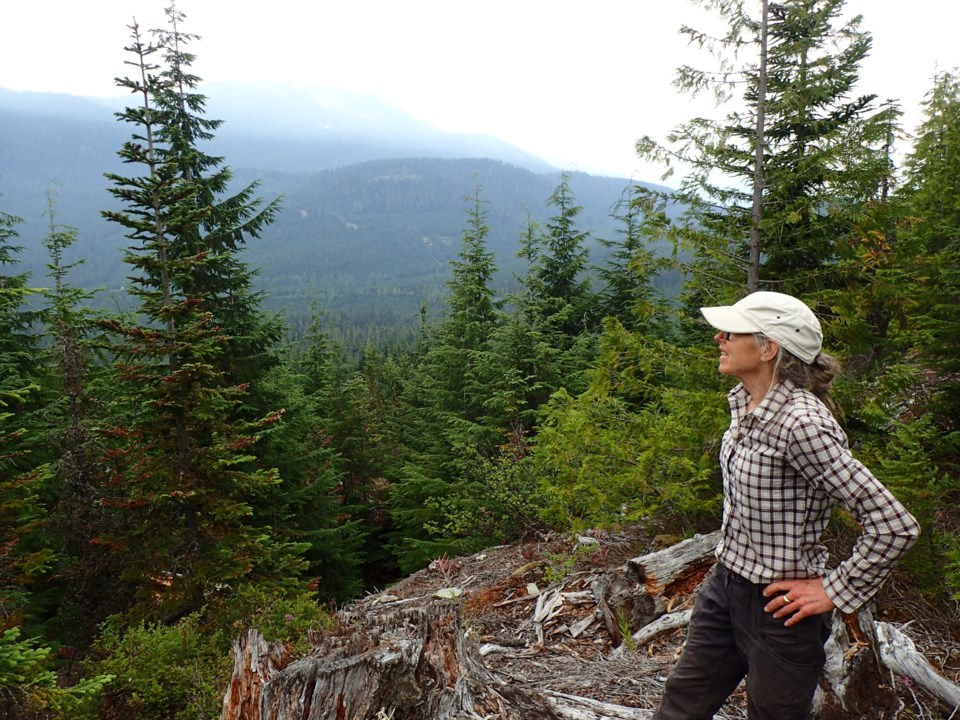A Whistler ecologist who has long argued against fuel-thinning in the region has put her money where her mouth is and her mind to the topic, and released a peer-reviewed, self-funded study that supports her thesis that thinning the forests around Whistler as part of fire mitigation efforts actually increases the risk of fire in an ecosystem that is naturally more resistant to fire than forests in other parts of Canada.
Rhonda Millikin, who has previously brought her concerns with fuel thinning to the Resort Municipality of Whistler (RMOW), has since carried out a study on the forests around Whistler with the help of a statistician, a retired fire scientist and volunteers over a two-year period. The study looked at the impact of thinning by comparing the microclimate of the forest floor in thinned areas and unthinned areas.
According to the findings of the study, which were published this month, “fire thinning led to warmer, drier, and windier fire environments.” Data was gathered from four sites around Whistler over spring and summer seasons, comparing both thinned and unthinned sections of forest by collecting environmental and microclimate data from the forest floor.
Speaking to Pique, Millikin said she had set out to test her concerns with the practice after not receiving much in the way of interest from those behind the local processes back in 2021.
“My goal was to pause what we were doing until we knew it was the right thing to do,” she said.
As it turns out, her research supports her concerns, which were initially informed by her extensive experience in ecology and working for Environment and Climate Change Canada.
In her article, which is published online by MDPI, an open-access publishing platform, Millikin and her co-authors say their research showed forested areas that undergo fuel-thinning see microclimate variables change in the direction of an increase in wildfire potential, with more solar radiation reaching the forest floor, increased ambient temperature, and higher wind speeds. Combined with decreases in relative humidity, soil moisture, and snow depth and cover in spring conditions, fuel-thinning is increasing wildfire potential.
“The results of this work suggest the natural resilience [of the forest] has been compromised by thinning,” reads the paper.
“Given that fuel moisture and response time of fuel are predicted from relative humidity, and surface temperature is a function of ambient air temperature, wind speed, and solar radiation, fuel-thinning in Whistler’s coastal forests has unquestioningly increased forest fuel flammability.”
Speaking to Pique, Millikin said she wants to see a complete change in orthodoxy in preparing communities like Whistler for wildfires, stressing that Coastal forests like those in Whistler are not suitable for fuel-thinning as applied to other geographic areas of B.C. and Canada.
“I’d like them to stop the fuel-thinning now in our forests around Whistler, and enable me to work with FireSmart and focus on the infrastructure protection that we’re hoping to do, and a within-Whistler fire response.
“Take the money that we save from fuel-thinning and apply it to the Whistler fire department. Get a new firetruck, put in sprinklers on the periphery of our neighbourhoods for any herbaceous plants, and start with neighbourhood responses. This is a more viable way of managing fire in our part of the world.”
Currently, fuel-thinning is a major component of the RMOW’s fire preparedness strategy, with the forests thinned and undergrowth cleared to prevent the potential of fires spreading to the forest crown in efforts that are carried out in multi-year stages and costing significant investment. In 2024, the RMOW was focused on Emerald West, Brio, and along Highway 99 in its fuel-thinning project, in what it refers to as vegetation management.
The orthodoxy is vegetation management improved forest health and resiliency, and allowed it to grow into old-growth forest compared to what exists now: In many cases, dense, young forest that is the unmanaged regrowth from clearcut logging in prior decades.
But Millikin said the FireSmart approach, and that of fuel-thinning, is a “one-size-fits-all” approach.
“It’s not appropriate in Whistler, so we need to have our own fire management approach,” she said.
“We are increasing fire susceptibility by changing the microclimate… on top of that, we’re compromising the natural resilience of the forest.”
Millikin argued the benefits of trees are well-understood in that they provide shade, hold the hillside together and are vital in fighting climate change, but the approach and understanding of the value of the natural environment is lost in fire management, which appears to be more informed by forestry as a sector rather than ecology.
“I look at that forest and I see the ecosystem process because I’m an ecologist. I’m looking at whether that forest is functioning, and beyond the tree as a source of money, beyond the tree as a piece of timber,” she said. “That’s the way a forester looks at it, they don’t look at the wildlife, the soil, microbes. It's very surprising. What we’re looking at here is an old-school approach of managing fire. It’s changing, but it's not changing fast enough. We’ve got to take control of this as our community forest.”
The complete study was published online on Aug. 14, 2024 on MDPI.
Check back with Pique in the weeks ahead for more on this story.




